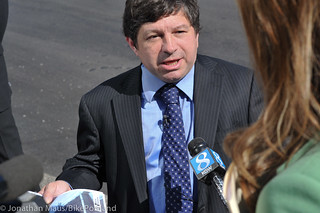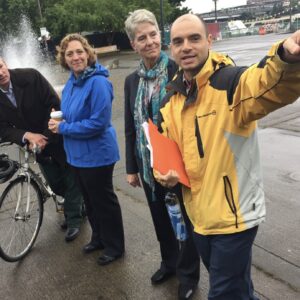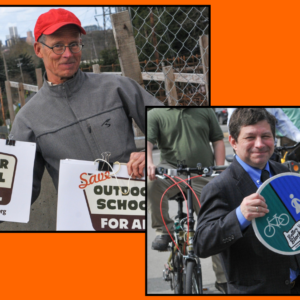When is a traffic study not a traffic study?
“Let’s work together to make Barbur safer,” Portland Transportation Commissioner Steve Novick wrote in October 2013, promising that “the Portland Bureau of Transportation will commit the time and resources to work with ODOT and engage the surrounding communities to see the impacts of a possible road diet and find the right solution.”
Now, some of the advocates who helped persuade Novick to make that commitment are saying it’s still unfulfilled.
“An average of 1-2 people die every year on this section of Barbur and many more, like my friend Henry Schmidt, have their lives changed forever. If the Southwest Corridor plan is 12 years from completion that is 12-24 more of our neighbors’ lives lost.”
— Kiel Johnson, Friends of Barbur
In an open letter to Novick circulated last week, Kiel Johnson of the Friends of Barbur advocacy group wrote that because the Oregon Department of Transportation has been steadfastly saying that its study of traffic diversion during last summer’s construction doesn’t count as a study of an actual redesign, the city should keep demanding that it conduct a real study.
At issue are two miles of Southwest Barbur Boulevard, roughly between between Miles and Hamilton just south of downtown Portland. Because the wooded stretch of road has almost no intersections, it feels a lot like a freeway — and has seen six deaths, five of them speeding-related, over the last five years.
The lack of intersections also means that removing a northbound travel lane wouldn’t have the major effects on traffic capacity that it might on a more urban stretch of road — it’d merely reduce traffic weaving and extreme speeding. So advocates including Johnson have argued for replacing a northbound passing lane with a dedicated bike lane and walking path on each side of the street.
Advertisement
Here’s Johnson’s letter:
Dear Commissioner Novick,
I am writing you regarding my concern for traffic safety on Barbur Blvd, particularly the wooded section, and the letter you wrote to the “Barbur Road Dieters” over a year ago. I am the founder of the Friends of Barbur group and helped get over 500 community members and groups to sign the petition asking for the study of a road diet on Barbur. We are still waiting.
Yesterday, I attended the SWNI transportation committee meeting where ODOT presented their traffic analysis during the recent construction on Barbur. At the beginning of the presentation Susan Hanson, from ODOT, announced that this was not a study of the road diet and no conclusions about a road diet should be made from this. Further she said that any additional conversation about a road diet should happen under the SW Corridor high capacity transit plan. This plan is focusing on the long term transit needs of the entire corridor. What we need is to look at the short term safety needs this very dangerous section in Portland. In your letter you agreed:
“The Southwest Corridor resolution is about affirming our agreement with our regional transit partners on the Southwest Corridor Plan, which is focused on the future of high capacity transit in the corridor. I would rather not link the Barbur road diet study to the Southwest Corridor resolution… The idea of a Barbur road diet is something I think should be studied regardless of whether there was such a thing as a Southwest Corridor Plan focused on high capacity transit. The Southwest Corridor plan will take shape over a dozen years; I would like to do a Barbur road diet study in a dozen months.”
My question to you is, what happened? We have been waiting over a year for a study that never happened. I am a big believer in the power of government to make people’s lives better. I created a Facebook group called “support the street fee” to counter the negative one and as a small business owner with 5 employees I picketed in front of the town halls in favor of the fee. I did this because I believed that reasonable people can come together to agree on commonsense plans to make our community safer.
A road diet makes sense on Barbur, especially after the minimal impacts ODOT discovered in their study. So far ODOT has refused to look at any of the safety benefits of a road diet on Barbur or even what a road diet might look like. In 2013, three people died in the same intersection on Barbur traveling at high speeds. Speeding on Barbur has to be brought under control. An average of 1-2 people die every year on this section of Barbur and many more, like my friend Henry Schmidt, have their lives changed forever. If the Southwest Corridor plan is 12 years from completion that is 12-24 more of our neighbors’ lives lost. As we sacrifice these people I think we need to at least know why ODOT has decided to lump a Barbur safety project in with such a long term project.
You told us, “We do want to study the idea of a road diet and plan to do so” and I believed you. Making Barbur safer will require a leader. I hope that you are that person and you have a community of people ready to support you.
Sincerely,
Kiel Johnson
www.friendsofbarbur.com
(For the record, the business Johnson mentions is the Go By Bike shop and valet at the base of the Aerial Tram in the South Waterfront. His views here are his own.)
In a separate interview Tuesday, Carl Larson of the Bicycle Transportation Alliance said he sympathizes with the fact that Novick made a promise that’s difficult to keep: convincing another agency to do a study.
But Larson said he agrees with Johnson that this was indeed what Novick wrote.
“He does make what seems to be a pretty solid commitment to do more than what is done so far,” Larson said. “I don’t think that’s due to blockages coming from the city of Portland. But I don’t think ODOT has necessarily made any commitments that they’ve defaulted on, other than putting safety first.”
So far, Johnson says he’s received no response from Commissioner Novick. We’ll let you know if/when he does.








Thanks for reading.
BikePortland has served this community with independent community journalism since 2005. We rely on subscriptions from readers like you to survive. Your financial support is vital in keeping this valuable resource alive and well.
Please subscribe today to strengthen and expand our work.
All this, just to have Barbur’s bike lanes be made continuous across the road’s two bridges north of Terwilliger. This is going to be one hard sell.
A road diet would do far more than make the bike lanes continuous. The main goal as I understand it is to reduce speeds along the road as most of the deaths are related to excessive speed. The improved bridge crossing are just one of the additional benefits that could be realized with a road diet along this section.
“…The main goal as I understand it is to reduce speeds along the road as most of the deaths are related to excessive speed. …” bjorn
Stopping deaths by collision on the road is a worthy objective, if a road diet would accomplish that objective, though it’s doubtful the road diet would do this. If you recall, remind us what times of day the collisions of people driving, resulting in their deaths, occurred. If those deaths occurred during commute and high traffic hours, somewhere along the stretch of Barbur between Terwilliger and town, along which the two bridges are located, then maybe, a road diet could help reduce or prevent deaths of people driving on the road.
Find out and report here, whether any of the five deaths of people driving occurred at times other than late at night when the road had little traffic. And how many. Late at night when there’s few other vehicles on the road, is when some people like to open it up and drive crazy on the road. And occasionally, one of them dies doing so. The road diet, two lanes merging into one isn’t likely to change that behavior. If anything, the squeeze may just add to the thrill.
Slowing down traffic on the road could more easily, effectively and maybe more economically accomplished, with lower posted speed limits and photo radar speed limit vans. These things are more realistically obtainable goals than have a road diet installed, likely is. And it would be great if people deciding to drive at excessively high, dangerous speeds on the road were deterred from doing so, by automatic documentation and citation, when they decide to drive crazy.
speed enforcement vans are manned by traffic division officers. I don’t believe there is an overnight crew for such things. Also, the law specifies the van cannot be in one place for more than 2 hours, and warning signs have to be placed in advance of the enforcement spot. Lastly, there has to be space to park the van, a frequent issue in SW.
Fixed cameras would be of benefit.
The speed control vans and related methods of speed management on Barbur, ought to be given considerable consideration. They work well, for example on Canyon Rd between Sylvan and West Slope, another potential speed alley.
FIVE people can not run a growing city of over 600,000 people…they just do not have the time to understand everything involved.
We need DISTRICT elections. This Victorian City Council structure we have has got to go. I have been trying to give Novick the benefit of the doubt, but it is getting progressively more difficult to do.
I’m not necessarily convinced we need districts (they promote parochialism) but we do need double the number of councilors. There is also no city the size of Portland left in the entire country with a mayor-commissioner form of government. A strong mayor system has been proposed at various points throughout the history of Portland — it has been voted down every time.
If there are no districts, what’s to stop this new 10 person council from having people live in the same 4-5 inner neighborhoods?
We need representation on a local level. The vast majority of commissioners have had little knowledge or experience of what goes in large swaths of the city. This is a huge problem.
Inner neighborhoods? 3 of 5 are in SW, only one in Eastmoreland and another in Grant Park.
Not sure if any of those count as what people think of as “Portland.”
I’m willing to say that Multnomah Village and Hillsdale have a lot more in common with “inner neighborhoods” than they do with East Portland. Unless we’re talking about lack of sidewalks and bike infrastructure, then you might be on to something…..
And while maybe not entirely true for this current council, I’d say this historical map supports my statement: http://www.oregonlive.com/portland/index.ssf/2014/07/101_years_of_portland_city_cou.html
Where do you draw the district boundaries and who gets to do this? The devil’s in the details. It’s very easy to gerrymander boundaries to either pack a lot of people into one district or spread people into several different districts, depending on what your objective is.
This is a pretty easy one. Draw the boundaries to roughly correspond to the six “quadrants” of the city: Southwest, Northwest, North, Inner NE, Inner SE, and East. Each one elects a councilmember. Then you have 3 councilmembers elected at-large, to form a 9-member council, plus a strong Mayor elected at-large as well.
So Goose Hollow and West Portland elect the same councilor? You think those neighborhoods have the same issues or priorities?
This is not that easy.
West of the Willamette = 2; Willamette to 82nd = 3; 82nd to east border = 3
I have seen some pretty terrible outcomes in other large cities with a district structure. The turf battles can get pretty bad.
Five people *don’t* run a city of 600,000 – they manage it. The city is “run” by dozens of people directly appointed by those 5 to head the various departments. It makes sense to have 5 at the top – a large enough group to have variation in opinion and direction, but small enough to maintain the ability to make decisions and act on them. It’s not an ideal system, but it’s far better than “strong mayor”, and far better than a district system.
Where real change is necessary is in the public holding people’s feet to the fire, and remembering when the city council or the department heads fail to meet publicly-stated goals. That’s the real challenge, because it involves citizens taking it upon themselves to stay informed, to remember or write down what people say when campaigning, while elected, or when appointed; and then networking with others, writing letters, and attending meetings. By and large, Joe or Jane Average Citizen isn’t able/willing to make that commitment.
I don’t agree that uprooting the system and rebuilding it will result in a more equitable, more efficient, or more effective city government.
Agreed. I ride Barbur every day and have for four years. It’s much better now with the improved ramps up on to the bridge sidewalk and the addition of the fence on top of the guard rail.
They failed at attempting to raise some kind of tax to fund, studies, safety or asphalt projects. They are on the hot seat, have a little sympathy and look at everything that’s been going on. Run for office, the view is different from the inside looking out
I haven’t been much of an activist heretofore –mostly just ride everywhere.
But now I am a father and I think I better get involved on this issue, seeing as how I ride Barbur every day.
People’s lives matter more than someone saving a minute speeding on Barbur.
I’ll contact Novick. Anybody have ideas on how else to get involved, let me know.
Thanks.
Who wants to help organize and publicize a “die-in” / “stop de kindermoord” type protest in front of the ODOT regional offices in downtown? Contact me at bikeloudpdx@gmail.com !
Background, and a very moving photo, on “Stop de kindermood”, a movement which made the Netherlands the world leader in bike/ped-friendly roads.
https://departmentfortransport.wordpress.com/tag/stop-de-kindermoord/
We should ask ODOT which member of their staff they’re okay with dying on that stretch. People’s live should not be viewed as acceptable expenditures.
They would then send out an e-mail to their staff asking which among them would like to design a road diet for Barbur, and then choose the first person that responds as the answer to your question.
But seriously, to everyone that says “ODOT doesn’t care about safety and protecting vulnerable roadway users from motorized vehicles!”, I say BALONEY! All you have to do is look directly outside ODOT’s front door (the Google Street View is here: http://bit.ly/1ttkQcY). They clearly understand that a physical barrier (in the form of large concrete bollards) is a preferred tool to be used when needing to provide a form of safe separation.
Now we just need to convince them that the lives of people traveling along Barbur (by means of driving, walking, biking, etc.) matter just as much as the lives of people walking in and out of their front door.
How about a separated bike / pedestrian bridge on both of the Barbur overpassed (SW Iowa Street trail and the one south of it) ? A separated bridge with benches would allow incredible viewpoints of Mount Hood, trees, and SE Portland.
That will be nice to have in the future, but this stretch of road needs help right now. People are dying every year because of speeding encouraged by this unsafe road design, and the fix requires nothing more than new signs and paint.
Personally I have avoided Barbur my whole life (20 years riding) because you need to have a death wish to ride that road. Luckily there are many ways to get into downtown from SW.
Terwilliger, Corbett (work them legs on the ride back up!), down Riverview cemetery then along the river, etc.
I would gladly do some hills than take Barbur.
Are there more than than the 3 you listed? Those are about the only ones I can come up with (unless you want to go down Boones Ferry, which dumps you into John’s Landing which has its own set of bike ability problems).
“Are there more than than the 3 you listed?”
It depends on where you are coming from/going to, but one that I often take from downtown is SW Vista and then cut over to Montgomery and up to Fairmount. It is a nice work out on relatively quiet streets. From there you have several good options for getting to destinations.
From NW, ride up through Washington Park to Skyline and continue over to SW Hewett.
Both of these are safe and scenic, but are not easy.
All are longer with more hills. Are you enjoying life as a second-class citizen?
Or alternately, as a citizen of privilege — someone who has the disposable time and flexible workplace situation that aids folding a scenic tour and arduous workout into the commute.
Novick is going to have PBOT taken away from him soon, anyway.
Who the heck is a friend of active transport on the city council?
Greater issues than biking in this conversation are: public health, economics, pedestrians, equity. I see no fault in BikePortland reporting on the bike aspect of such improvements, but the argument needs to be reframed from bikes vs. the rest of the world to human health and safety.
wsbob: Have you carefully reviewed the contents of ODOT’s Report released in December?
Facebookers please join People for a Safer Barbur Blvd if you care about this cause.
https://www.facebook.com/groups/peopleonbarbur/
I agree completely. After all, drunk and/or reckless drivers have caused the deaths not only of cyclists, but also of pedestrians (and of course have derailed their own lives). And the consequence of their actions have affected not only the persons directly involved (perps, victims, and survivors), but also their families. The point being, everyone would be better off once we have a sensible road diet and police enforcement of speed limits.
Novick, your job might be difficult, but you should have the prioritization skills to recognize that people’s lives are important.
Novick and the city spent $250,000 for the chain link fence on the Vista bridge and are looking for $3 million for a permanent fix to keep people who want to kill themselves from being hurt but they are not willing to spend money to help protect people that want to live?
“…but they are not willing to spend money to help protect people that want to live?” Jon
It’s the public’s and not Novick’s and the city’s money to spend any way he and it may wish. Aside from some people that would like Barbur’s bike lanes to be continuous across the roads two bridges north of Terwilliger, the public isn’t crying out to put in the road diet in order to accomplish this.
Novick and the city don’t have near the mandate to put the road diet to Barbur, that they do to putting up a fence try stop people from jumping off the Vista to their deaths. People that want to ride, and that don’t want to deal with Barbur motor vehicle traffic, could take Corbett. A little longer, less direct, more climbing, but in some ways, a better street to ride.
Or, they could move their house, or they could get a new job or change careers. Or they could learn to fly. People could do a lot of things to avoid Barbur, but why should they have to? Why should we keep making excuses for a broken street?
Barbur is a highway, not a street, and it’s not broken. The road diet isn’t going to do anything to make the road safer for biking. The road diet’s creation of room for continuation, not presently there, of bike lanes across the bridges, will make biking on this highway a bit more convenient, but that’s about all.
With the ‘diet’, motor vehicle traffic will most likely travel at very close to the average speed it does now, in with the same number of motor vehicles and more in years to come. With various negative consequences arising as a result of this degree and character of use.This is the biggest issue the road poses to other uses of the road through the area it passes, and to use of the road for biking.
Taking that issue head on by citing the road’s present degree and character of use as being detrimental to area livability and to functionality other than almost exclusively as a high speed highway in and out of Portland, may stand some chance of arranging for lower posted speed limits on the road. Slower traveling motor vehicles on the road, the result being their creation of less noise, and greater ease by which people biking the road would be able to transition to the main lane for crossing the bridges.